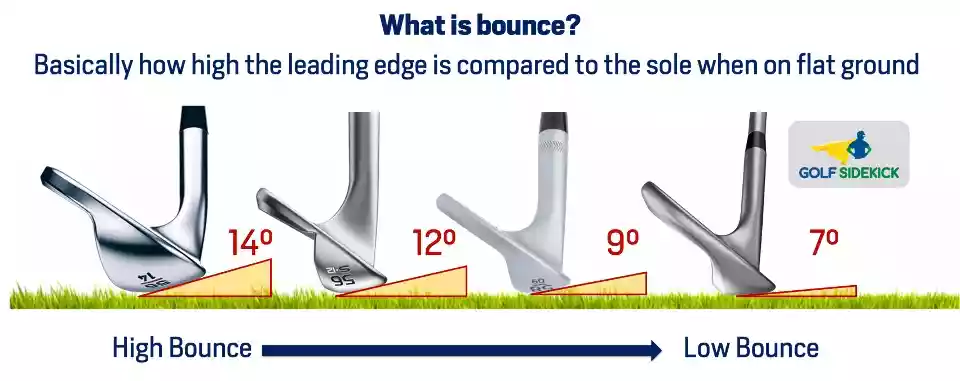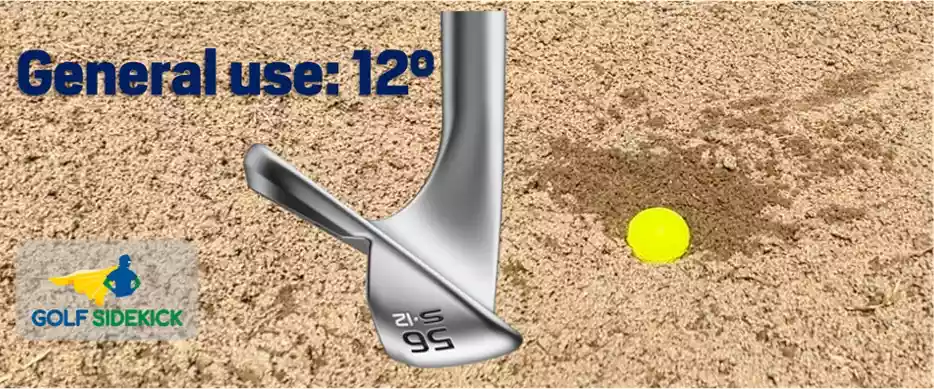Last Updated on December 26, 2023 by Matt Greene
We've all heard the golf saying "drive for show, putt for dough" but I think a more accurate version would be "drive for shot, wedge and putt for dough." Average golfers hit 65% of the shots in their round from inside 100 yards, and many of those are going to be with a wedge of some kind.
How many times have you met a buddy at the course and he's told you about his new wedge? Never, I bet. Golfers love to show off their new $500 driver but aren't that excited about a new wedge. I would probably bet most players have never, or will never replace their wedges.
The major problem is that many recreational golfers think that wedges are reserved for pro golfers and are not going to impact THEIR OWN game that much. I often get asked by high handicappers who watch my channel when to use a 56 degree wedge. I'll show you below how to get the most out of this important score-slashing club.
When should I use a 56 degree wedge?
For the majority of handicap golfers, the 56° wedge is an excellent choice when used for every shot inside 100 yards.
A 56 degree wedge can be used for all of these shots:
- Green side bunker shots
- Partial pitch shots between 20 and 80 yards
- Smooth full shots to the maximum distance you can control the ball
- Green side chipping
- Long bunker shots of 30-50 yards
- Chipping out of the deep rough back into the fairway

Here what we're going to cover in this article:
- What is a 56 degree wedge?
- One wedge or many wedges?
- 56 degree wedge distance
- 56 degree wedge vs sand wedge
- Why use a 56 degree wedge?
- How a 56 degree wedge can lower your scores
What is a 56 degree wedge?
A 56 degree wedge is often called a sand wedge. The number 56 refers to the number of degrees of loft that the club face has. It is one of the shortest clubs in the bag and is used to hit shots inside 100 yards. Despite being called a sand wedge, you can use the club for shots from the tee, fairway and rough. It's a great club to have in your golf bag.
One wedge or many wedges?
Approach 1 - One wedge: I've seen a few golfers employ the one wedge tactic. They use their 56 degree wedge for every shot inside 100 yards, from full swings, to pitch shots and bunker shots. Pro Mo uses one wedge for everything and he is a professional, though he prefers the 58 degree.
I HIGHLY recommend this approach for wedging with high handicappers. It's much simpler to use this one club for everything inside 100 yards until you have enough skill to get the specialist lob wedge.
There are a few reasons reason for doing this, the main one being to attempt to master one scoring wedge and eliminate any indecision from this important part of the golf course. It makes sense because using a sand wedge for everything, you learn how it interacts with different lies, turf and sand conditions. You can use this knowledge for the rest of your life.

If you do decide to go down this avenue and play with one wedge, here are the shots you will need to learn and master:
- The bump and run. This is an essential shot for all golfers, especially higher handicappers as it reduces the margin for error when playing chip shots. Getting the golf ball rolling on the putting surface early is a better percentage play and can be achieved even with an average strike. To play the bump and run with a sand wedge, you will need to play the ball off your back foot, delofting the club to encourage it to roll out and not spin too much.
- Standard chip. This may seem like the easiest shot to learn but its actually quite hard to master. You have to remove any wrist hinge and allow the loft of the sand wedge to pop the ball up in the air. You can then vary the length of your backswing and follow through to increase the height and distance the golf ball will travel.
- Flop shot. While not essential, if you are playing with one wedge you will need to learn how to open up the face of the club and generate more loft. The trick with a flop shot is to not decelerate and thin the golf ball. Play the ball off your front foot, take a wide backswing and commit to striking the ball high. Hopefully it will fly high into the air and land softly. Channel your inner Phil Mickelson.
Approach 2 - Many wedges:
Each wedge can be a specialist tool to use for different shots around the green. We also want consistent gaps between wedges for full shots. I'm not the best at taking distance off my wedges so I want to be able to make a committed swing, knowing the wedge in my hand will make the golf ball go a desired yardage on full shots.
When I'm around the green, I also like to assess the lie of the golf ball and choose the appropriate golf club for the job. I will use my 56 degree wedge for most shots, but I like to have options. Is the ball plugged in a bunker? I might close the face on my 52 degree gap wedge. Golf ball sitting on a hard pan lie on dry golf course? I'll use my lob wedge as it has less bounce. This approach is is best for if you have some experience playing golf.
I have played for 25+ years so if you're new to the game, or having a tough time inside 100 yards, you can select the 56 degree alone and get good with it. They usually come with a set of irons so no need to purchase a specific one. You just need to practice.
When you head to the golf course you want to be so confident with your approach shots that you can hit every chip shot onto the green and leave yourself a putt. We can always make putts. The more you practice and get comfortable with your selected club, you will play great golf and smash your scoring barriers.
How to use a 56 degree wedge
I'm a firm believer that you should never make a full swing with anything below a pitching wedge. A high lofted wedge is a precision tool and for consistent performance you need to make swings which you know will result in a tight dispersion.
Pro Mo on my channel uses the Dave Pelz clock system to dial in his wedge distances. This a technique also used by Bryson Dechambeau who used it to win the US Open. Explained simply, you take the club back to imaginary points on a clock face. If the bottom of your swing is 6 o'clock, a full swing would be up to 11 or 12 on the clock face. Learn which "time" on the clock gives you what yardage and repeat this process.
The key with all wedge play however is to make solid contact. Better golfers will be striking the centre of the club face with these short clubs giving them maximum distance control. Solid contact comes from practice and good technique. it's impossible to teach someone through text or video how to hit the ball solid with good technique. An in person lesson with a good coach will always be the best option.
Quick tip: To work out where you're striking the ball on the face of the club, spray the head with dry shampoo before a practice session at the driving range. When you hit the ball, you will see a mark where it struck the face and you can adjust you swing and ball position to lock in a center strike.
56 degree wedge vs sand wedge

A 56 degree wedge is the most common loft for sand wedges and obviously is a great club to use out of bunkers. It's in the name - sand wedge.
Choosing the right wedge to use out the sand is based on the bunker conditions of your course - this will influence the bounce of the club you select. If the sand is soft and fluffy, you want more bounce and a nice big sole. Usually, soft fluffy sand accompanies soft and moist ground, where you want the same type of wedge - bigger sole and higher bounce.
If the course you play at is firm and hard, with firmer hardpan bunkers, you definitely need a thinner sole and lower bounce so the club will not skim and bounce up into the ball, causing a bladed shot.
If a bunker shot isn't your strong suit, check out bunkers for beginners.
Why use a 56 degree wedge?
The 56 degree wedge is a club that every golfer becomes familiar with in their golfing journey. The score-slashing takes place inside 100 yards so the sand wedge is a club which you will be using a lot.
The average golfer may only need to play one lofted wedge, and a 56 degree wedge is probably the most versatile. You can use it from the tee, fairway, thick rough, and sand to play a variety of shots.
Yes a 60 degree may seem like the cooler option, but in reality it's not the best club selection for most golfers. A 60 degree wedge is just harder to hit. If you really want to play a lob wedge, consider a 58 degree. The truth is, a 56 has more than enough loft, and with some practice and creativity it can be your secret weapon and key to hitting more greens.If you have a gap between your pitching wedge and sand wedge, check out how to use a 52 degree wedge.
56 degree wedge distance
The average distance a male golfer hits his 56 degree wedge is 80 yards. For a PGA Tour pro it's 124 yards.
The 56 degree wedge is the key to lower scores
Believe it or not but a scratch golfer hits only around 10-12 of the greens in regulation in a round. Most double digit handicappers are hitting only 3 to 8 greens in regulation. That leaves between 12 and 15 holes to chip and putt to save scores.
What these stats show is that you MUST have sharp short game regardless of your handicap! Getting up and down from around the green in 2 shots will be the difference between bogey and double and par and bogey. I bet that in every great round you had, you had periods where you were scrambling like a demon! Even the pros do this and the secret is their short game.
Being a savage with your 56 degree wedge, learning how to play a wide variety of shots with it, will allow you be in greater control of your golf ball and your score. Hit an approach shot to the short side? Not worries, you're a demon with the sand wedge and you can get up and down. Hit it in the green side bunker? Easy life.
Many golfers neglect their wedge game for their driving. Don't be that guy. Fully utilize the tools you have at your disposal and GET IT ON THE GREEN!
